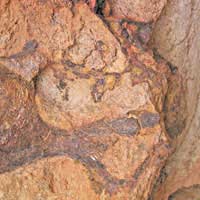
The study of the chronological history of life on earth as observed in the fossil record is the science called palaeontology. Simply put, the palaeontologist is a fossil hunter. However, the archaeological bone specialist on an archaeological expedition is searching for more than just dead dinosaurs.
Palaeontology extends to cover all extinct life forms, human, animal, plants, fungi, and even microscopic bacteria. In fact anything that once lived in the geological past can be studied if it has been preserved by the elements of nature in the earth’s thin upper crust. The specialisation of scientifically studying bones is an anthropological subdiscipline called osteology.
Principal Function in Archaeology
There are a great many sub-fields in palaeontology usually defined by the subject under investigation. Classifications such as vertebrate or invertebrate in animals, single celled or multi celled in other smaller organisms, or even the methods that could cause fossilization are all individual sub fields and carry with them their own title and techniques. In archaeology, however, the principal function of the osteologist is to acquire, analyse, record, and render an interpretation on bone artefacts, both human and animal, located at the excavation site.
Palaeontologists set ancient life in its historical context by analysing how the world’s geography and climatic changes have affected the ecosystems in which societies existed. Therefore, palaeontologists must interact with the geologist, the botanist, the zoologist, and the biologist if their interpretations and submissions are to offer any authority.
Prominent Palaeontologists
The most prominent palaeontologist is unquestionably Charles Darwin, whose research was to become the foundation stone of a new theory in anthropology. Women also featured as fossil hunters and Mary Anning was an acclaimed early British palaeontologist notable for her discovery of the first plesiosaur fossil in 1821. Ten years earlier, when Mary was only 12 years old, she had discovered the first complete ichthyosaur fossil near her family home in coastal Dorset, England.
Analysis Techniques
Osteologists on the digging site study the remains of early hominids and animals, both domesticated and feral. Remains could include preserved bone such as fragments, teeth, whole bones, and more rarely, entire skeletons. Research will also incorporate the tools that were made from bone.
The techniques for analysing bone remains from antiquity have advanced from simple to sophisticated where, today, the osteologist is at the forefront of ancient dental detective work using particle vaporizing laser technology. Teeth are one of the best-preserved bone remains and offer the osteologist a wealth of information. For instance, living tooth enamel absorbs the chemicals released by edible food plants. Each dietary foodstuff leaves an exclusive chemical signature in the tooth’s living tissue. The signature is frozen in time by fossilization or preservation and when unearthed the osteologist can determine what was on the ancient menu by laboratory analysis of the extant enamel.
Most professional palaeontologists and osteologists are also employed as lecturers and professors at universities and museums. They will often complement their vocational passion by teaching an allied science such as geology or biology.